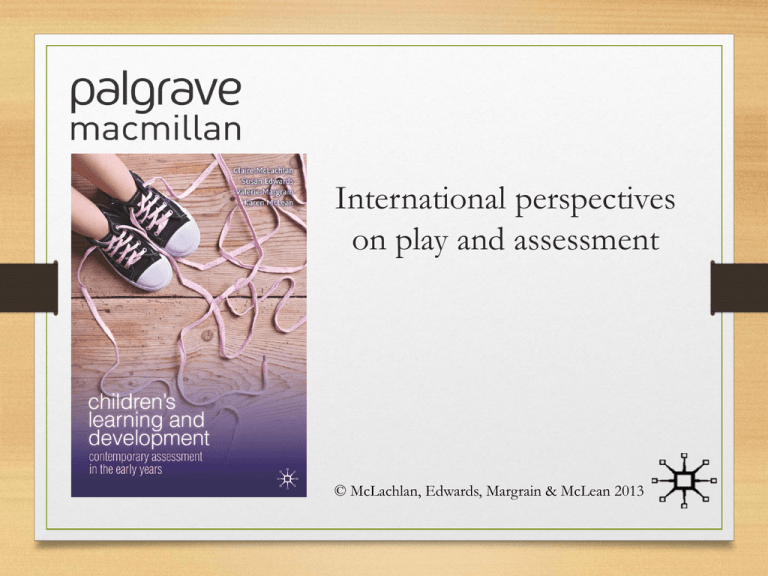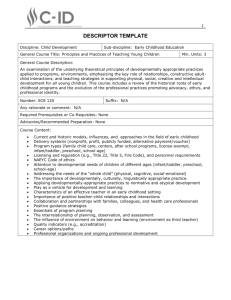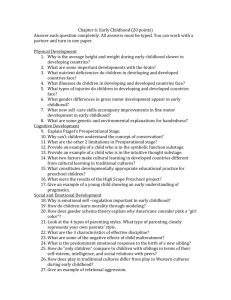Play
advertisement

International perspectives on play and assessment © McLachlan, Edwards, Margrain & McLean 2013 Play and assessment • Because early childhood education typically views play as closely linked with learning it is important to reflect on the ways in which play can be variously understood and therefore related to assessment in the early childhood curriculum: It [play] has become synonymous with learning in the early childhood years. This is not surprising when you think about the amazing growth of children during the ages from birth to five years of age that occurs for the large part outside of formal educational settings, and the mastery of skills and knowledge about their world that they acquire during this time. (Yelland 2011, p. 4) Ideas in the history of play in early childhood education • Early theorists such as Rousseau, Frobel and Dewey emphasised the idea that play provided children with the freedom to learn (Platz and Arellano 2011) • Piaget argued play connected children with the external world. Children could explore and experiment with phenomena and construct explanations for how things work (Krogh & Slentz 2010) • Vygotsky suggested children work to understand relationships between objects and meaning, and use these to explore the social roles available to them in their communities (Eun 2010) • Post structuralist ideas consider how power operates within children’s peer relationship and play or how play can reinforce gender stereotypes (Ailwood 2011) Why consider the history of play? • Saracho and Spodek (1995) suggested it is important for educators to understand the history of play because how play has been viewed in the past influences how it is understood and used in the present • The history of play can be seen in curriculum documents for early childhood education. These documents describe play in ways that connect with the theoretical and philosophical ideas that have been important in the field • Being aware of how play is understood in a curriculum document is important because it influences how educators are likely to plan for and assess learning Descriptions of play from international early childhood curricula documents Developmentally Appropriate Practice Guidelines (USA) Children of all ages love to play, and it gives them opportunities to develop physical competence and enjoyment of the outdoors, understand and make sense of their world, interact with others, express and control emotions, develop their symbolic and problemsolving abilities, and practice emerging skills. Research shows the links between play and foundational capacities such as memory, self-regulation, oral language abilities, social skills, and success in school. (National Association for the Education of Young Children 2009, p. 16) Descriptions of play from international early childhood curricula documents Framework for Kindergarten Curriculum (Singapore) Play is vital to children’s learning. Play is a vehicle for motivating children to explore, discover, take risks, make mistakes and cope with failure. It permits them to be involved in organising, making decisions, making choices, practising, persevering and expressing feelings. (Ministry of Education 2003, p. 25) Descriptions of play from international early childhood curricula documents Early Years Foundation Stage (UK) Play is essential for children’s development, building their confidence as they learn to explore, to think about problems and relate to others. Children learn by leading their own play, and by taking part in play which is guided by adults. There is an ongoing judgement to be made by practitioners about the balance between activities led by children, and activities led or guide by adults. (Department for Education 2012, p.6) Views on play • Different communities have different values and beliefs about what education should achieve for young children (van Oers 2008) • These values and beliefs are reflected in curriculum documents that talk about play and how it is associated with learning (Drummond 2010) • Some communities will see play as being about exploring the world and constructing understandings; other communities will view play as a social experience that values interactions between peers and adults • One perspective is not necessarily more valid than another. They offer views on play that relate to what is valued within a particular context Play and assessment • How curriculum documents describe play influences how they articulate the role and purpose of assessment • Understandings of play point to particular views of learning, and views of learning relate to educator approaches to assessment Framework Core ideas about play Helps children understand and USA NAEYC make sense of their world statement on Interact with others, express and Developmentally Appropriate Practice control emptions Develop symbolic and problem(2009) solving skills Essential for development United Kingdom Builds confidence through Early Years exploration, problem solving and Foundation Stage relation to others (2012) Mix of adult-led and childinitiated activity Vital for learning Framework for Motivates exploration, discovery, Kindergarten risking taking Curriculum in Supports mistakes and coping Singapore (2003) with failure Involves children in organising, making decisions, practising, persevering and expressing feelings Children learn through play Aotearoa New Zealand Te Whariki Active, and interactive with others Testing ideas (1996) Using resources Sweden Curriculum for the Preschool (2010) Stimulates imagination, insight, communication and symbolic thinking Supports opportunities for cooperation Context for problem solving Description of assessment Assessment also is a tool for monitoring children’s progress toward a program’s desired goals. In developmentally appropriate practice, the experiences and the assessments are linked (the experiences are developing what is being assessed, and vice versa); both are aligned with the program’s desired outcomes or goals for children. Teachers cannot be intentional about helping children to progress unless they know where each child is with respect to learning goals. (p. 22) Assessment plays an important part in helping parents, carers and practitioners to recognise children’s progress, understand their needs, and to plan activities and support. Ongoing assessment (also known as formative assessment) is an integral part of the learning and development process. It involves practitioners observing children to understand their level of achievement, interests and learning styles, and to then shape learning experiences for each child reflecting those observations. (p. 10) Observing and recording children’s progress is vital for programme planning and evaluation. If adults are to meet the developmental needs of children, they will need to refer to these records and observations on a regular basis. (p. 35) Assessment of children’s learning and development involves intelligent observation of the children by experienced and knowledgeable adults for the purpose of improving the programme. Assessment occurs minute by minute as adults listen, watch, and interact with an individual child or with groups of children. These continuous observations provide the basis of information for more in-depth assessment and evaluation that is integral to making decisions on how best to meet children’s needs. (p. 29) The quality of the preschool shall be regularly and systematically documented, followed up, evaluated and developed. Evaluating the quality of the preschool and creating good conditions for learning requires that the child’s learning and development be monitored, documented and analysed. Supporting and challenging children in their learning entails knowledge of each child’s experiences, knowledge and participation, as well as influence over and interest in the different goal areas. This also requires knowledge of how the child’s exploration, questions, experiences and involvement are used in the preschool, how the child’s knowledge changes and when they experience the preschool as interesting, fun and meaningful. (p. 14) Conclusion • Being clear about how play is understood in curriculum frameworks is an important aspect of understanding how assessment is framed • Play has a complicated and rich history in early childhood education and elements of this history can be seen in a range of international curriculum frameworks • Perspectives on play have implications for how assessment might be described and also the role of assessment in early childhood education • Play, learning and assessment are related concepts, processes and experiences in the context of early childhood settings. What is valued in terms of play is often reflected in how the purpose and approach to assessment is described Key terms • Curriculum frameworks – government policy document that outlines the approach, goals and learning outcomes for young children. • Play – a way of understanding children’s learning used by curriculum frameworks to help teachers think about how to develop and implement early childhood education. • Assessment practices – the range and type of approaches to assessment early childhood teachers use to gather information for understanding children’s play, learning and development.






